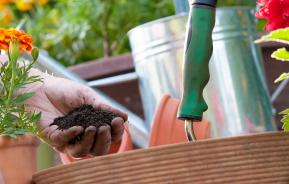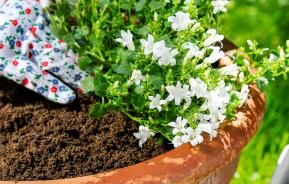It’s no secret that moving house is one of the most stressful experiences you’re likely to go through, especially if there is any landscaping or hardcore maintenance work that needs doing.
Of course, it’s also an experience that’s packed with many delights. If you’re a regular visitor here at Lovethegarden.com the chances are you agree with us, when we say that one of the greatest (and least mentioned) delights and pleasures of a new home has to be discovering and breathing new life into the garden.
Where to begin?
Perhaps it goes without saying that it depends on what sort of state your new home and garden are in when planning how to get started. Don’t go cutting back everything you see, without devising an action plan!
Assess your garden
In an ideal world, we’d suggest that you live with your new garden for a year before you start any radical work and at the very least, wait until the end of the first summer. The reason being of course, that it can take a while for you to work out what existing plants you actually have as well as which areas do well.
In fact just like your new home, you sometimes just have to live with your garden a while to get a good idea of your garden plans. It’s also the best way of discovering whether that sunny corner gets completely waterlogged or hit hard by the frosts come the onset of winter and that knowledge could save you valuable time and money.
Create a plan
Once you have got to know your garden, it is time to make a plan. This way you know what you want for your end result and you can seasonally map out the steps to take to get there.
What if the garden is very overgrown?
You can call in landscape professionals to raise the whole lot to the ground but they may use chemicals that you don’t want to be used and they may just annihilate some secret treasures.
Hidden wonders may emerge from a brambly corner as you head into spring, a crop of saplings may reveal a fruit tree or two at the onset of summer or even a vegetable plot, and an overgrown bed of weeds might actually be hiding some wonderful autumn colour as the summer begins to fade.
It’s all in the preparation
So instead, cut back and weed what you can, when you can, taking time so that you start to get a feel of what was there before. Arm yourself with a book of plants (or better yet, check out our plant finder!) so that you can identify any unknowns and start to cut back and prune any familiar old friends, who’ve grown straggly or overrun.
There are probably hundreds of little maintenance jobs you can start with as you recapture your garden, that you can also fit in as a welcome break to the decorating or home renovations. With each little section weeded or pruned, whatever was there before will slowly start to reveal itself.

The top 3 things most gardens will need doing
1. Pruning/cutting back of hedges
This is a commonly neglected job in the garden. You can make your garden seem a lot bigger just by doing this as the first port of call when you move in.
2. Levelling the lawn
Most lawns go through wear and tear over the long term which can be a big job to get it right depending on the state of it. There are a number of reasons for this which you can identify and resolve in our lawn levelling guide.
3. General weeding
This is another neglected job and can vary in severity. You will often have to do a thorough once-over of all paths, patios, lawns and beds in your garden when you move house.
What do you want from your garden?
Before you start digging that dream flower bed or border, make sure you have a good idea of how much time you have to dedicate to the re-design of your garden, what you want from your new outdoor space, how much time you have for maintaining it and most importantly, what your budget is.
There’s no use spending hundreds of pounds on intricate floral beds if you have a house full of children or pets who are going to kick a ball around and play hide and seek in your borders. But if homegrown produce is something you’ve always dreamt of, perhaps now is the time to start building those beds.
And if it is a major redesign that you’re thinking of it may also be worth asking for help from a reputable garden designer, getting advice from your local nursery or spending as much time as you can, reading up on garden design.
Success is in the detail
Whatever the condition of your soil, homemade compost made with kitchen scraps and garden waste is a great addition and even if it’s not time to start planting, it’s never too early to start making your compost. Set aside a corner of your garden for this and a bin in your kitchen and if you’ve got a lawn, add the grass cuttings too.
Make a note if you don’t know already of which areas face north or south, what are the sunniest spots, which bits catch the wind and what offers a sheltered or well-drained position.
Then enjoy all the pleasures of an almost blank canvas.
After all the waiting, planning and weeding, the pleasure or injecting your garden with a new lease of life is going to be all the greater. We hope you enjoy every moment of it, as each new section comes to fruition, as you enjoy your first homegrown veggies, admire your first blooms or just sit in a sunny corner for the first time in the warm evening light.
If you have any before and after photos, why not share your gardening journey with us on our social media sites and your efforts may just inspire some of our other readers!








